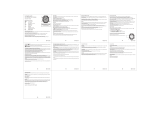
1. SAFETY............................................................................................................................................................ 4
2. Welcome.........................................................................................................................................................5
3. Introduction....................................................................................................................................................6
4. Getting started...............................................................................................................................................7
5. General settings........................................................................................................................................... 9
5.1. Changing units...................................................................................................................................9
5.2. Changing general settings............................................................................................................ 9
5.2.1. Button tone.............................................................................................................................9
5.2.2. Tone guides...........................................................................................................................9
5.2.3. Backlight............................................................................................................................... 10
5.2.4. Language..............................................................................................................................10
5.2.5. Activating button lock....................................................................................................... 10
6. Using time mode..........................................................................................................................................11
6.1. Changing time settings................................................................................................................... 11
6.1.1. Setting time............................................................................................................................. 11
6.1.2. Setting date............................................................................................................................11
6.1.3. Setting dual time..................................................................................................................12
6.1.4. Setting sunrise and sunset times.................................................................................... 12
6.2. Using stopwatch............................................................................................................................. 12
6.3. Using countdown timer.................................................................................................................12
6.4. Setting alarm.................................................................................................................................... 13
7. Using ALTI & BARO mode......................................................................................................................... 14
7.1. How Alti & Baro works.................................................................................................................... 14
7.1.1. Getting correct readings......................................................................................................14
7.1.2. Getting incorrect readings................................................................................................. 14
7.2. Setting
profiles and reference values........................................................................................15
7.2.1. Matching profile to activity.................................................................................................15
7.2.2. Setting
profiles.....................................................................................................................15
7.2.3. Setting reference values................................................................................................... 15
7.3. Using weather trend indicator..................................................................................................... 16
7.4. Activating storm alarm................................................................................................................... 16
7.5. Using altimeter profile.................................................................................................................... 17
7.5.1. Using altitude dierence measurer................................................................................. 17
7.5.2. Recording logs..................................................................................................................... 17
7.6. Using barometer
profile.................................................................................................................18
7.6.1. Recording logs......................................................................................................................19
7.7. Using automatic profile.................................................................................................................. 19
7.8. Using depth meter profile............................................................................................................20
Suunto Core
2























